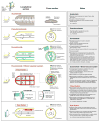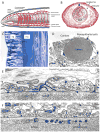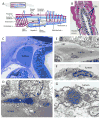Evolutionary origins of the blood vascular system and endothelium
- PMID: 23809110
- PMCID: PMC5378490
- DOI: 10.1111/jth.12253
Evolutionary origins of the blood vascular system and endothelium
Abstract
Every biological trait requires both a proximate and evolutionary explanation. The field of vascular biology is focused primarily on proximate mechanisms in health and disease. Comparatively little attention has been given to the evolutionary basis of the cardiovascular system. Here, we employ a comparative approach to review the phylogenetic history of the blood vascular system and endothelium. In addition to drawing on the published literature, we provide primary ultrastructural data related to the lobster, earthworm, amphioxus, and hagfish. Existing evidence suggests that the blood vascular system first appeared in an ancestor of the triploblasts over 600 million years ago, as a means to overcome the time-distance constraints of diffusion. The endothelium evolved in an ancestral vertebrate some 540-510 million years ago to optimize flow dynamics and barrier function, and/or to localize immune and coagulation functions. Finally, we emphasize that endothelial heterogeneity evolved as a core feature of the endothelium from the outset, reflecting its role in meeting the diverse needs of body tissues.
Keywords: biological evolution; blood vessels; endothelium; heart; phylogeny.
© 2013 International Society on Thrombosis and Haemostasis.
Figures







References
-
- Nesse RM, Bergstrom CT, Ellison PT, Flier JS, Gluckman P, Govindaraju DR, Niethammer D, Omenn GS, Perlman RL, Schwartz MD, Thomas MG, Stearns SC, Valle D. Evolution in health and medicine Sackler colloquium: Making evolutionary biology a basic science for medicine. Proc Natl Acad Sci U S A. 2010;107(Suppl 1):1800–7. doi: 10.1073/pnas.0906224106. 0906224106 [pii] - DOI - PMC - PubMed
-
- Tinbergen N. On aims and methods in ethology. Z Tierpsychol. 1963;20:410–33.
-
- Brusca RC, Brusca GJ. Invertebrates. Sunderland, Mass: Sinauer Associates; 2003.
-
- Ruppert EE, Carle KJ. Morphology of metazoan circulatory systems. Zoomorphology. 1983;103:193–208.
Publication types
MeSH terms
Grants and funding
LinkOut - more resources
Full Text Sources
Other Literature Sources

